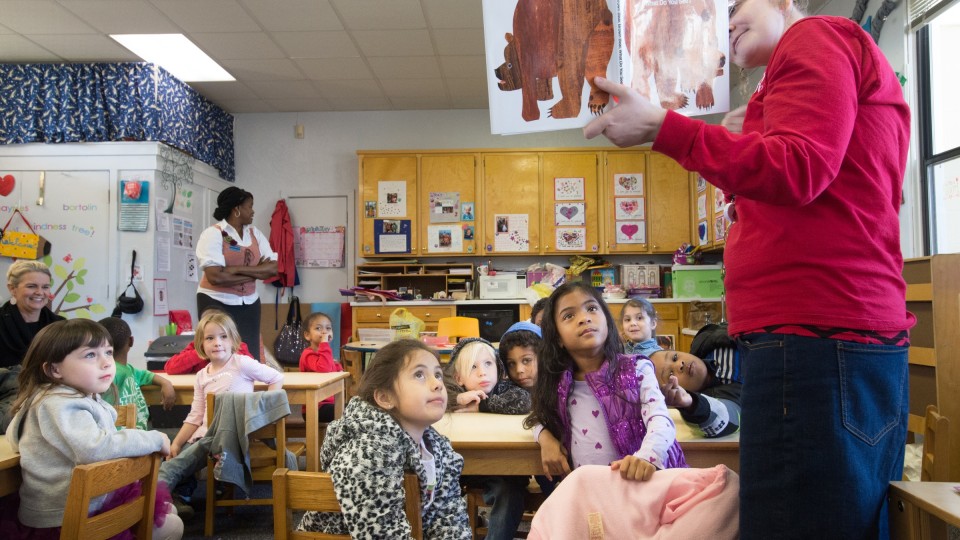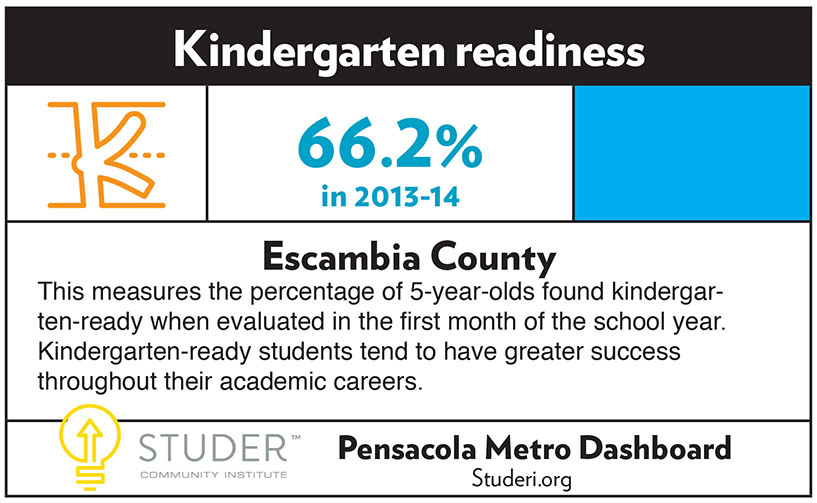It makes sense to invest in preschool
- March 15, 2016
- / Reggie Dogan
- / education

Heather Haynes reads to her class at T.R. Jackson Pre-K center Thursday February 11, 2016 in Milton, Florida. (Michael Spooneybarger/ CREO)
Growing evidence indicates that young children who participate in high-quality pre-k programs enter school more ready to learn than their peers.
High-quality programs also provide cost savings to federal, state and local government, research shows.
Bottom line: It makes sense to invest in preschool.
In fact, a leading economist in the social protections and health division of the Inter-American Development Bank in Washington, D.C., is telling anyone willing to listen that funding early childhood education is a worthy investment that pays big dividends.
Caridad Araujo works in poverty-reduction and early-childhood-development programs, designing projects and allocating funds to countries in Latin America and the Caribbean.
In “An Economist’s Case for Pre-K,” a comprehensive Q & A that appeared this month in The Atlantic, Araujo outlined the importance of supporting and investing in early learning.
Interviewer Juleyka Lantiqua-Williams wrote:
When city government leaders in San Antonio decided to fund a prekindergarten program using sales tax revenues, they made a case that doing so was an economic imperative as a growing city, that investing in the future workforce was about the city’s future prosperity, and that remaining attractive to companies and workers meant having a more educated population. Other compelling factors were the city’s increasing Hispanic population, its high poverty index, urban sprawl, and an underfunded early-education system.
To be sure, the benefits of high-quality pre-K are immeasurable. It is critical to closing the achievement gap between children of different economic backgrounds and for preparing them for kindergarten, primary school and beyond.
Expanding access to and investing in early learning and high-quality preschool programs provides a win-win solution: improve outcomes for children, defray costs for low-income working families and prepare our future workforce for economic competiveness, all while saving taxpayers money in the long run.
But instead of investing more to help prepare children, we have pulled back on early childhood programs.
Because of cutbacks and stagnant funding, fewer children receive childcare assistance today than two decades ago.
Today’s infants and toddlers are bearing the brunt of inequality and soaring child poverty rates.
Two randomized controlled trials, or RCTs, have been conducted to measure the effects of high-quality early childhood education.
The Perry Preschool Project in Michigan and the Carolina Abecedarian Project
in North Carolina followed participants to measure long-term effects of things like incarceration rates, teen pregnancy, average education level, average income, among other things.
Both found huge economic and social gains to high-quality preschool.
Bruce Watson, executive director of Escambia’s Early Learning Coalition, says his agency offers a 16 to 1 return rate for those who attend preschool vs. those who don’t.
That means for every dollar invested in the early education of a child, $16 is saved in social service spending.
The coalition locally manages the state programs that are aimed at improving kindergarten readiness, one of 16 metrics on the Studer Community Institute’s Pensacola Metro Dashboard.
The Studer Community Institute Dashboard’s kindergarten readiness metric shows that 66.2 percent of Escambia County’s 5-year-olds are ready for kindergarten.
Of the nearly 3,000 kindergartners in Escambia County Schools this year, about 1,000 of them weren’t ready for school.
Florida is among only three states that offer prekindergarten for all 4-year-olds — Georgia and Oklahoma being the others.
More than 175,000 4-year-olds statewide participate in VPK, which is 77 percent of all eligible children.
In the first year of VPK in 2002, the state allotted $2,500 for early learning per child. More than a decade later, the allotment is $2,437 for each child in VPK, less than when it started.
When will policymakers invest fully and adequately in real quality early education?
Education experts maintain that children need access to affordable, high-quality education that promotes early learning and school readiness.
As interest in pre-K has increased and more states have implemented pre-K programs, policymakers have identified core requirements for program success. These include: Highly trained teachers with expertise in early childhood education, learning goals tied to K–12 standards, low child/staff ratios, and small class sizes.
Model pre-k programs validate the benefits of hiring teachers with a strong background in education and training. More recent state pre-K studies also document the effectiveness of programs with certified teachers with college degrees.
When asked the most effective methods for financing early-childhood education programs, Araujo said:
We know that the highest return on investment in early childhood intervention occurs when those investments are targeted at families that are very disadvantaged, and when the actual services provided are very high quality. In terms of priorities, I would imagine that any programs with money that is spent on the children that are facing the biggest range of vulnerabilities and disadvantages are going to see a very high return on investment.

 CivicCon launches with a look at good growth in cities
CivicCon launches with a look at good growth in cities
 Building stronger brains one baby, one parent at a time
Building stronger brains one baby, one parent at a time
 SCI debuts commercial on Early Learning City
SCI debuts commercial on Early Learning City
 Entrecon: World class speakers and an opportunity to sharpen skills
Entrecon: World class speakers and an opportunity to sharpen skills
 PYP Quality of Life survey 2017
PYP Quality of Life survey 2017
 EntreCon Pensacola 2016: A look back
EntreCon Pensacola 2016: A look back
 Leadership tip: getting better employee takeaways
Leadership tip: getting better employee takeaways
 Leadership tip: be interested instead of interesting
Leadership tip: be interested instead of interesting
 Leadership tip: delivering difficult messages
Leadership tip: delivering difficult messages
 Brain Bags boost Arc, Early Childhood Court programs
Brain Bags boost Arc, Early Childhood Court programs